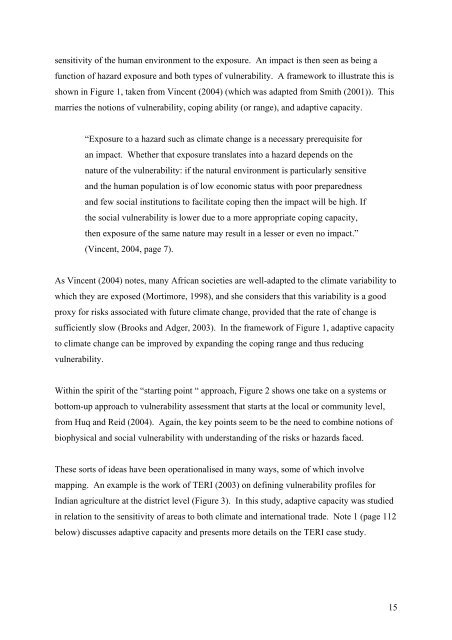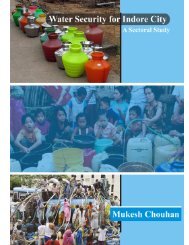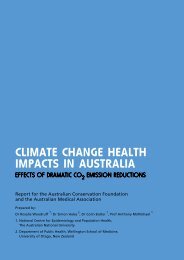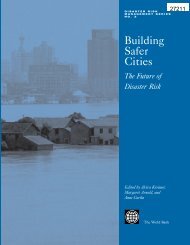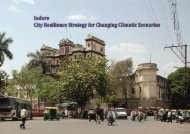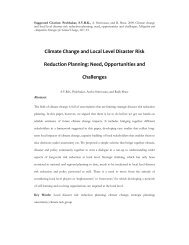Mapping climate vulnerability and poverty in Africa - CGSpace Home
Mapping climate vulnerability and poverty in Africa - CGSpace Home
Mapping climate vulnerability and poverty in Africa - CGSpace Home
You also want an ePaper? Increase the reach of your titles
YUMPU automatically turns print PDFs into web optimized ePapers that Google loves.
sensitivity of the human environment to the exposure. An impact is then seen as be<strong>in</strong>g a<br />
function of hazard exposure <strong>and</strong> both types of <strong>vulnerability</strong>. A framework to illustrate this is<br />
shown <strong>in</strong> Figure 1, taken from V<strong>in</strong>cent (2004) (which was adapted from Smith (2001)). This<br />
marries the notions of <strong>vulnerability</strong>, cop<strong>in</strong>g ability (or range), <strong>and</strong> adaptive capacity.<br />
“Exposure to a hazard such as <strong>climate</strong> change is a necessary prerequisite for<br />
an impact. Whether that exposure translates <strong>in</strong>to a hazard depends on the<br />
nature of the <strong>vulnerability</strong>: if the natural environment is particularly sensitive<br />
<strong>and</strong> the human population is of low economic status with poor preparedness<br />
<strong>and</strong> few social <strong>in</strong>stitutions to facilitate cop<strong>in</strong>g then the impact will be high. If<br />
the social <strong>vulnerability</strong> is lower due to a more appropriate cop<strong>in</strong>g capacity,<br />
then exposure of the same nature may result <strong>in</strong> a lesser or even no impact.”<br />
(V<strong>in</strong>cent, 2004, page 7).<br />
As V<strong>in</strong>cent (2004) notes, many <strong>Africa</strong>n societies are well-adapted to the <strong>climate</strong> variability to<br />
which they are exposed (Mortimore, 1998), <strong>and</strong> she considers that this variability is a good<br />
proxy for risks associated with future <strong>climate</strong> change, provided that the rate of change is<br />
sufficiently slow (Brooks <strong>and</strong> Adger, 2003). In the framework of Figure 1, adaptive capacity<br />
to <strong>climate</strong> change can be improved by exp<strong>and</strong><strong>in</strong>g the cop<strong>in</strong>g range <strong>and</strong> thus reduc<strong>in</strong>g<br />
<strong>vulnerability</strong>.<br />
With<strong>in</strong> the spirit of the “start<strong>in</strong>g po<strong>in</strong>t “ approach, Figure 2 shows one take on a systems or<br />
bottom-up approach to <strong>vulnerability</strong> assessment that starts at the local or community level,<br />
from Huq <strong>and</strong> Reid (2004). Aga<strong>in</strong>, the key po<strong>in</strong>ts seem to be the need to comb<strong>in</strong>e notions of<br />
biophysical <strong>and</strong> social <strong>vulnerability</strong> with underst<strong>and</strong><strong>in</strong>g of the risks or hazards faced.<br />
These sorts of ideas have been operationalised <strong>in</strong> many ways, some of which <strong>in</strong>volve<br />
mapp<strong>in</strong>g. An example is the work of TERI (2003) on def<strong>in</strong><strong>in</strong>g <strong>vulnerability</strong> profiles for<br />
Indian agriculture at the district level (Figure 3). In this study, adaptive capacity was studied<br />
<strong>in</strong> relation to the sensitivity of areas to both <strong>climate</strong> <strong>and</strong> <strong>in</strong>ternational trade. Note 1 (page 112<br />
below) discusses adaptive capacity <strong>and</strong> presents more details on the TERI case study.<br />
15


